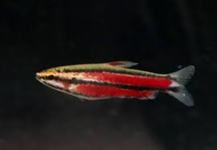RED PECILFISH II (NANNOSTOMUS RUBROCAUDATUS “RIO HUALLAGA”)
$16.50
Full Description
The pencilfish is such an interesting surface dweller that everyone should keep at least once. These hardy and active fish come with pointy snouts and slender, pencil-like bodies, as described by their common name. Plus, they exhibit unique behaviors that differ from your typical schooling fish. If you’re interested in getting an unusual nano fish for your next community tank, learn about the wonderful world of pencilfish.
What are Pencilfish?
These distant relatives of the tetra family are from the Nannostomus genus and can be found in multiple countries all over South America. Many species are available in the aquarium hobby, such as:
- Hockeystick, diptail, or brown pencilfish (N. eques)
- Beckford’s pencilfish (N. beckfordi) — golden and red versions
- Coral red or red arc pencilfish (N. mortenthaleri)
- Purple pencilfish (N. rubrocaudatus)
- Dwarf pencilfish (N. marginatus)
- One-lined pencilfish (N. unifasciatus)
- Three-lined pencilfish (N. trifasciatus)
While most pencilfish swim horizontally like normal fish, some like the diptail pencilfish have the amazing ability to swim diagonally at a 45-degree angle. Since they are schooling fish, you should get at least six pencilfish of the same species. However, coral red and purple pencil fish can be feisty towards each other, so we recommend buying at least 8–10 (with a ratio of one male to two females) to lessen the aggression. Be prepared to save up if you plan on getting a larger school because prices can range from $3-25, depending on the species.
How to Set Up an Aquarium for Pencilfish
Pencil fish can fit in a 10-gallon aquarium, but we personally like a 20-gallon high or 29-gallon tank for them. These taller aquariums are great for displaying fish that swim at different layers, so you can get top-dwelling pencilfish, midwater fish, and bottom dwellers. (Coral red and Beckford’s pencilfish tend to swim midwater though, so plan accordingly.) Most pencilfish sold at fish stores are wild-caught and prefer tropical temperatures from 75–80°F (24–27°C) and pH from 6.5–7.5. Adding catappa leaves can help gently acidify the water if needed.
While pencilfish are not notorious escapers like killifish, they may jump if startled, so make sure to get a tight-fitting aquarium lid. Plus, the ornery species (e.g., coral red and purple pencilfish) need lots of live plants and tall decorations to block line of sight and minimize territorial disputes.
What fish can live with pencilfish? Pencilfish do well with similar-sized, peaceful fish in a community aquarium. Common tank mates include corydoras, tetras, and rasboras. Also, they are good dither fish that can help shyer species feel more comfortable and hide less, so hobbyists like to pair them with dwarf cichlids like apistogrammas. While some people have successfully kept them with betta fish, be prepared to separate them if the betta is too aggressive. Finally, cherry and crystal shrimp are not recommended since pencilfish are known to predate on them.
What do Pencilfish Eat?
Providing lots of high-quality foods is the key to keeping your pencilfish healthy. Because of their small, upturned mouths, they do best with tiny foods that float or take a long time to sink. (To help the food stay buoyant longer, avoid having fast flow near the water surface.) Our favorite foods to feed include baby brine shrimp, cyclops, daphnia, crushed flakes, and micro pellets
Pencilfish are easy to keep, do well in community tanks, and look lovely against a background of aquatic plants, so we hope you will enjoy them as much as we do. For more options to occupy the top half of your aquarium, check out our article on the 10 Best Top-Dwelling Fish for Your Aquarium.
Out of Stock

